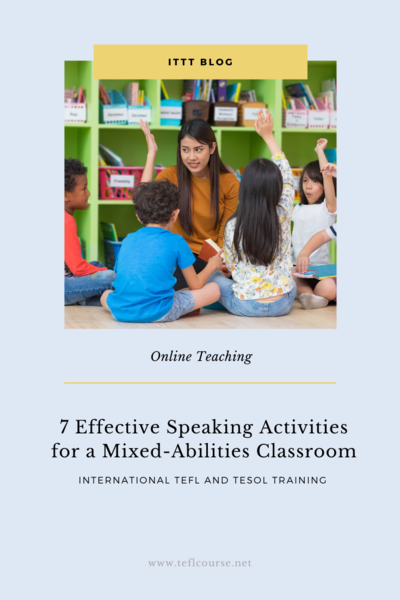7 Effective Speaking Activities for a Mixed-Abilities Classroom

Speaking is one of the most important skills (listening, speaking, reading, writing). We do not only help students to understand, write and read it, but also speak it fluently. Teaching speaking skills for a mixed-ability classroom is not easy.
Table of Contents
2. Say things about a picture.
6. I went to the shop and I bought
Do you want to teach English abroad? Take a TEFL course!
This post was written by our TEFL certification graduate Huyen N. Please note that this blog post might not necessarily represent the beliefs or opinions of ITTT.
When we are teaching a class with has students who are clearly of different levels. They may have different starting levels of English or they may learn at very different speeds. the teacher easy to get frustrated in a class of mixed ability. The students also feel bored and frustrated. The stronger students may feel held back, weaker students may feel pressured. The teacher may feel stress.
There are several strategies that a teacher can use to deal with the situation. We help students have the opportunity of communicating with other students.
I want to give some best activities for teaching a speaking lesson of a mixed-ability.
1. Pair or group.
The use of pair and group work is essential if we are to involve all the members of the class. A fundamental technique here is the use of questionnaires and interviews. By pairing off the weaker and stronger students and by involving both in the preparation and implementation of the questionnaire we should ensure maximum participation of all the students. we can then get the weaker students to interview their stronger peers and vice-versa. Of course, this may be frustrating for the stronger students, but if they can see their role as that of 'helper', or even mentor, it may also have a positive effect.for example, we can talk about "the weather" the students repair some questions such as: what's it like out? , how's the weather? what's the weather forecast ?....and get the students to interview each other.

Also Read: "Communicative Approach to Teaching Grammar"
2. Say things about a picture.
In groups of three, choose one member of the group to be 'secretary' and write ticks (/).Tell them they have one minute exactly to say as many simple sentences about a pictureas they can. All members of the group contribute, the 'secretary' writes a / for everysentence said. Stress that they should not try to write out the sentences, only saysthem! They can only start when you say 'go' and stop when you say 'stop'. Give themexactly one minute. Ask them to count up their ticks. Then tell them to do the same with another picture, trying to break their previous 'record'.
3. Speaking clocks
This is a good activity to foster positive pair work and encourage spontaneous speaking.Students stand in two equal numbered circles, one inside the other and face-to-face.The circles take it in turns to move like a clock, asking a question stipulated on the board by the teacher or of their choosing to the person facing them before moving on. When the time is up, it is the turn of the other circle to move.
Also Read: How long does it take to get a TEFL job?
4. How many?
Divide students into 2 groups. Then the teacher asks a question. Each group has to give answers. Which group can give more answers will be the winner.

5. Disappearing text
Write up the text on the board. Read out the text and drill. Rub off a small part of it. The student has to say whole the text again. gradually rub off more in bits and each time get the student to say whole the text.
6. I went to the shop and I bought
The classic memory game where each person adds a new item to the list in alphabetical order. For example student 1 went to the shops and bought an apple, student 2 went to the shop and bought a bike. …student 3 went to the shop and bought a coat…we can revise sports and the use of doing/play .. the same game but using different vocabulary.

Also Read: Teaching English in Hong Kong - The Salary and Budget Guide
7. Word
A very simple game where the student must think of words connected to the word that comes before. For example, the teacher says: fish, the next person thinks of a word they associate with 'fish' such as water…you can decide as a group if the association is valid. Ask the student to justify the connection. to make it more competitive, set a thinking time limit and eliminate students. when they are eliminated they can become judges.
Do you want to teach English abroad? Take a TEFL course!
Every student has the levels and learning styles are different. We need to invest time in getting to know about the students, we need to ask some questions about their strengths weaknesses, interests, objectives. It will help us understand more about your students and give activities suitable for our students.. and try to involve each student in every speaking activity, do not correct student's pronunciation mistakes very often while they are speaking. If we restrict students around forms or tough grammar rules, a student can't speak unfortunately, they start to be anxious about their mistakes in the time of speaking.
Apply now & get certified to teach english abroad!
Speak with an ITTT advisor today to put together your personal plan for teaching English abroad.
Send us an email or call us toll-free at 1-800-490-0531 to speak with an ITTT advisor today.
Related Articles:
- Step-By-Step Guide to Legally Teaching English in China
- 10 Questions You Need to Ask Before Enrolling In a TEFL Course
- 5 Reasons Why You Should Teach English in China
- Online or In-Class - Which TEFL Course Should You Take?
- Teaching English Abroad: What's Next? - How To Advance In Your EFL Career
- Teaching English In China - The Salary and Budget Guide




